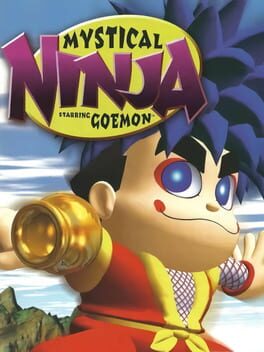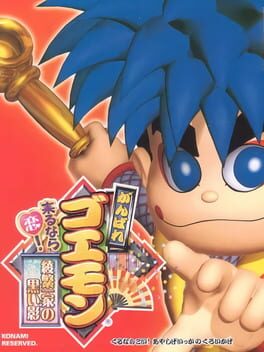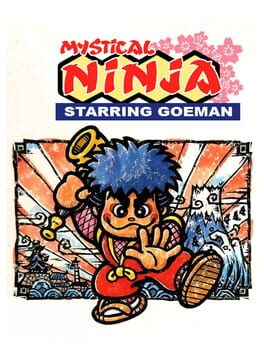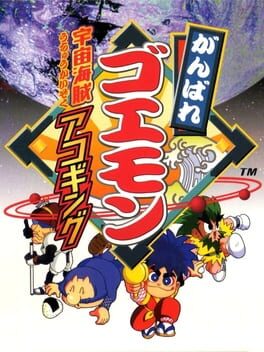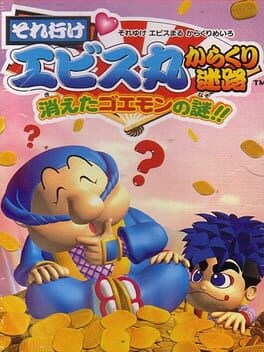

The story follows Goemon's struggles to prevent the Peach Mountain Shoguns gang from turning Japan into a Westernized fine arts theater. The plot calls for three cinematic musical features and battles between giant robots; like other Ganbare Goemon games, it is peppered with surrealist humor and anachronisms. The protagonist of Mystical Ninja is Goemon, a hot-blooded, kiseru-wielding ninja with blue, bushy hair based loosely on the legendary thief Ishikawa Goemon. The lord of Oedo asks him to find those who maimed Oedo Castle. Goemon lives in Oedo Town and is friends with Ebisumaru, a strange, gluttonous fat man who wears a blue bandana. Ebisumaru is defined as lazy and perverted. Their kunai-throwing friend Sasuke is a mechanical ninja (made by the Wise Man of Iga) who enjoys hot baths and Japanese tea. Rounding out the heroes is Yae, a fierce sword-wielding kunoichi, who happens upon Goemon's band in Zazen Town. The villains of the game hail from the organization Peach Mountain Shoguns and include a gang of four "weirdos" led by Spring Breeze Dancin' (Danshin Harukaze) and Kitty Lily (Margaret Ranko). They intend to transform Japan into a stage for their talents.
Also in series
Reviews View More
Mystical Ninja starring Goemon denies me of my usual stream-of-consciousness style for reviewing by positioning itself right in the middle of the quality scale. It excels at nothing, attempts nothing to excel at, and sleeps well in the warmth of anti-critical faux-nostalgia from those who did or don't have fond memories of the N64. I always say that boring games are worse than straight up bad games because they siphon every interesting quality out of a video game and instead of ruining them or bolstering them, mitigate them with a mind numbing lack of knowledge or ambition. This game is exactly that; a stepping stone for more ambitious devs to use as a reference point in what to avoid in design.
Every area in Goemon is stretched a mile long in an attempt to pad playtime. This would be fine, if Goemon and his peanut gallery had any sort of movement options to offer the more interested player a more enticing relationship between world and control, but they don't. Every ability and action is supplemented with 4 useless button presses in order to initiate when they could be delegated to 1- and are even further delayed by pointlessly long unattractive animations. This would be fine if the abilities and actions served any other purpose than to open locked doors in different ways or cease the delay of your movement forward, but they don't. Even when you do get abilities that allow you to circumvent the intended solutions for said lock-and-key puzzles, you're about 30 minutes from being rid of the game. On top of that, you can't enact any ability while moving, even ones that Make the player Move. It's pretty darn silly and I can only assuming intentionally stifling. I would be able to forgive these bouts of boring, standardized gameplay if the game kept up its witty, absurd comedy that is present within the first 10 minutes, but it doesn't. What I thought might be a middling gameplay experience upheld by its writing and gags immediately becomes a middling package wrapped up in a tone deaf bow.
The best joke in the game is when it introduced its secondary protagonist by throwing him out of a restaurant for streaking. That's the first cutscene. Everything else the game considers funny is on part of the pressured, underpaid localizers to erase any kind of marginalized hate terms slung at minority groups that Japan loves to hate. I can appreciate this game's dedication to recreating and paying homage to Japanese culture, accurate depictions of real locations, but it all falls apart when I look up "Mystical Ninja Goemon Okama."
The game isn't worth it and only offers a couple catchy songs, nicely baked-in cool bounce lighting in some areas, and it's overall visual dedication. Other than that, everything about Mystical Ninja Goemon deserves to be ignored. It brings to light no interesting conversation and even trying will be a waste of energy as I could just spend that energy forming a cooler conversation about a better game.
I don't really have much interesting to say, but neither does the game.
So middle fingers up, this shit is Goemid. It's not Mario 64 meets Ocarina of Time. You don't even know what that means. You don't even want that shit. Go to work.
It's still fun and varied mechanics today, with four playable characters with different abilities and unlockable skills. With its banger soundtrack (especially the boss theme song) and simple but satisfying gameplay, it's a game that does what it wants to do very well.
The most frustrating feature is the locked camera, I don't want to say game-breaking, but there were moments when I felt trapped and stuck. For me, it wasn't a negativity that would cover up the rest of the good things, but it's worth taking into consideration.
Goemon and Ebisumaru are escaping from the angry crowd at an inn when suddenly a giant peach-shaped spaceship comes out of the sky and transforms Oedo Castle into this weird, Western toy-looking thing. They then embark out first to save the lord of the castle and his daughter, and then on a quest to save Japan from the Neo Momoyama Shoguns who want to turn all of Japan into their own personal theater stage. This game was originally titled as Ganbare Goemon 5, but the '5' was dropped in order to try and show that it was a break from the older games in the series. Nonetheless, the markers of its continuation of the story of the previous games (however unimportant or trivial that may be) are there in how wacky this story is (and a reference here and there to the ending of Ganbare Goemon 4).
What's also unfortunate (but certainly unsurprising) are the continuation of all of the more rotten parts of Ganbare Goemon's humor, like the not infrequent homophobia and transphobia. It wasn't a deal-breaker for me, but it very well may be for some people, and the English script does tone it down a bit (though not THAT much). It does have some genuinely funny comedy in it as well as an aggressively silly tone packed with loads of 4th wall breaking, irreverent remarks, and even a laugh track. That combined with the several voiced musical numbers give the game an energy like something right out of a gag anime. When it works, it works pretty well and gave me a good few chuckles, but when it doesn't work, it's downright painful.
The game design is overall pretty strong. You have four playable characters, as many of the Super Famicom games do (although no co-op mode), going through a 3D adventure around Japan. Each character has 3 weapons (at least one of which uses money as ammo, in grand Goemon fashion) and a special power they can activate, and while they each play mostly the same, there are enough differences between the four of them that you'll likely develop a favorite among them. The game has five dungeons to go through with a handful of bosses and mini-games to tackle to progress through the game. The overworld is not super awesome, and can feel a bit needlessly empty at times, but there are many secrets to find, so it pays to keep your eyes open for the many heart containers (or rather, lucky cats) scattered throughout the world. The bosses are overall tackled fairly well, and although some of the dungeons can certainly run a bit long (the ability to save in the middle of them would've been very nice), they're well put together even if they tend to fall into the camps of "overly simple" or "overly maze-like" in their constructions.
The game's biggest problems are in a few deliberate design choices and then with technical problems. There are several fairly baffling design decisions, number one of which is that the game has absolutely no manual camera controls. This game is an early N64 game, sure, but 3D environments were not a new thing in 1997, especially given that Mario 64 came out the previous year. It isn't the worst auto-camera in the world, but damn if I wish it didn't have some way of controlling it to at LEAST recenter it behind you. Outside of some rough signposting here and there (despite a hint shop), there are some other strange decisions like not being able to pause during the Goemon Impact boss fights, or how despite how often well tutorialized the rest of the game is, you're never told how to actually fight in those boss fights.
Several boss fights in the game (the second and then two final ones) have you piloting Goemon's giant robot friend Impact. First, you have a really fun transformation sequence as Impact is summoned in (complete with vocal song behind it) followed by a brief sort of running section to bash baddies and buildings in order to build up ammo and health before you get to the boss. Then when you get to the boss, you enter a mode that's something between Star Fox 64 and Punch Out, and they're often brutal battles of attrition unless you know what you're doing already. I was stuck on the final boss for an HOUR (he has some attacks that go on for AGES) before a friend looked up a speedrun and told me of a Scorpion-style "GET OVER HERE!" grappling hook move I had no idea was present (which I then proceeded to use a lot to beat the everloving hell out of the boss). The R-button, which is otherwise totally unused in the game, launches that grappling hook, while Z fires money as projectiles, A does long punches, and B does quick jabs. There are even special moves you can do by doing certain combos, but the game never tells you ANY of this in the game. While I'm sure the manual for the game did tell you that stuff, it's very odd that the game itself never tells you any of this given how many other things are explained to you in it. Some of the mini-games are overly obtuse and frustrating in their own ways, but the Impact fights take the cake as far as inadequately explained mechanics go. The fights are fun once you know what you're doing, but if you don't then expect to have a really frustrating time (especially since the cursor in the first-person sections don't use inverted vertical aiming, and that takes a LONG time to get used to XP).
The last of the issues with the game are largely technical. Konami has a pretty bad track record on the N64 as far as releasing games that feel unfinished (like Castlevania 64, which genuinely IS unfinished), and this game is part of that legacy. Even for an early N64 game, the frame rate is HORRIBLE and very inconsistent. There were many parts where it was chugging so badly that it began to affect the latency of my button inputs, and while it isn't exactly game breaking, it is impossible to ignore in a game where platforming is so important yet pressing A sometimes results in a very late or a totally absent jump. Then finally there are some significant collision problems. Enemy and character hitboxes are very oddly defined, with hits often hitting but sometimes bafflingly missing, and there even being one type of platform (the fans in the last stage) that I routinely clipped through for no apparent reason. The game's difficulty is overall quite forgiving (your health bar is pretty big and only gets bigger while health items are quite cheap), so these problems never made me feel like the game was unplayable, but it was quite frustrating and they do a lot to drag down a game that could otherwise be one of the best experiences of its type on the system.
What isn't a slack at all, however, is the presentation. It's a 1997 N64 game, so it's VERY polygonal, but the art style on the characters at least holds up pretty darn well. Environments look pretty flat and unimpressive in the overworld, but dungeons are often whimsically put together in a way that makes them memorable. The MVP of the game is easily the music, though. The soundtrack is an absolute banger even outside of the vocal tracks. The dungeons even have a really cool mechanic where the songs start out simple but then slowly get more complex as you delve deeper into them. The excellent music is one facet carried over from old Goemon that still runs as strong as ever, and even if you don't check out the game, the music should still be looked at X3
As far as regional differences go, there are a few but they're usually not very important. The biggest and most noticeable one is that the opening and ending movies have voice acting in the Japanese version of the game, which adds a fair bit more character to the game in a way I really enjoyed. Aside from that it's largely small aesthetic things (like replacing the manji on grappling blocks with a star) and translation decisions. A lot of Ebisumaru's lines in particular are wordplay that simply can't be translated, and from what I understand the English version of the game has a translation that walks the line of "poorly translated, or deliberately wacky?".
Verdict: Hesitantly Recommended. This is a weird one to recommend because it has so many problems, but if you can get past those and play the game as it is, then there's a lot to be enjoyed here. Especially for mid '97, this is a really incredible feat for the N64's library, and is one of the best 3rd party Japanese developed games on the platform in my experience (if we aren't counting Rare as 3rd party, anyhow :b). The technical issues and writing problems are the biggest obstacles to my recommendation, and I can't give it a higher one because those are a lot more difficult to tolerate, generally, in 2021 than they were in 1997, but if you're ready to take the plunge then there is a lot of enjoyment to be had here among the jank.
